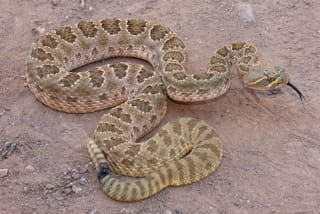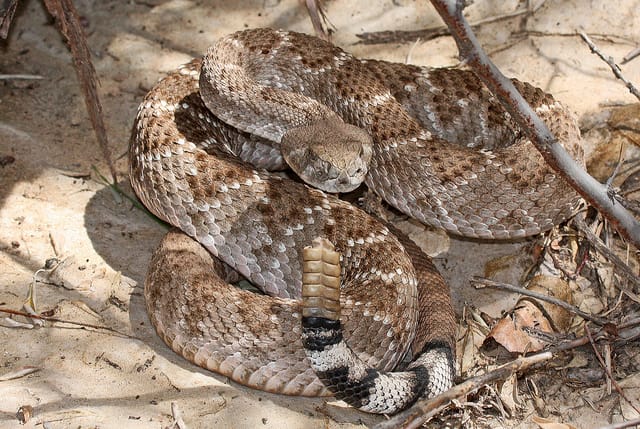This guide initially displays common reptiles and amphibians of all shapes. Use the selectors below to view particular shapes, include rare species, or search by name.
Reptiles are a group of vertebrate animals that are cold-blooded, i.e., they regulate their inner body temperature by responding to the temperature of their environment, basking in the sun to warm themselves up or lying in the shade to cool off. Animals in the class Reptilia include snakes, lizards, crocodiles, turtles and tortoises. All of these creatures are covered in scales and breathe air through their lungs throughout their lifetime. In addition, they all produce eggs. Most reptiles lay eggs from which young hatch directly after an incubation period. However, some snakes, including rattlesnakes, carry their eggs internally and then give birth to live young.
Like reptiles, amphibians (frogs, toads, newts, salamanders and worm-like caecilians) are cold-blooded vertebrates. However, unlike reptiles, animals in the class Amphibia do not have scales but rather have skin that is permeable so that molecules and gases can pass through it. In addition, they lay their eggs in water where the young are born as larvae using gills to breath. The larvae grow and change into the adult form. This process includes developing lungs thus allowing the adults to live on land. Amphibians are considered to be the link between fish and reptiles as they were the first animals to leave the water and come onto land.
The question often arises of how to tell the difference between a frog and a toad. Although they are closely related amphibians, there are some features that can be used to distinguish them. Frogs have long hind legs for jumping, moist and usually smooth skin and bulging eyes. In addition, they typically stay in water. Toads have short legs for walking and hopping, dry and bumpy skin and do not have bulging eyes but do have poison glands behind their eyes. They mostly stay on land.
This guide describes the modest number of amphibians and reptiles including two venomous snakes that can be found in Los Alamos and the surrounding areas. An excellent reference for more information is Amphibians and Reptiles of Los Alamos County by Teralene S. Foxx, Timothy K. Haarmann, and David C Keller.
Reptile and Amphibian References
Amphibiaweb
Amphibians and Reptiles of Los Alamos County [PDF]
Bartlett, R.D., Bartlett, P.P., 2013 New Mexico’s Reptiles and Amphibians: A Field Guide. University of NM Press
Biota Information System of New Mexico
Degenhardt, W.G., Painter, C.W., Price, A.H., 2005 Amphibians and Reptiles of New Mexico. University of NM Press
eNature
Encyclopedia of Life
New Mexico Herpetological Society
The Reptile Database
Subject Area Experts (all guides)
Steve Cary (butterflies)
Beth Cortright (insects)
Terry Foxx (invasive plants)
Leslie Hansen (mammals)
Richard Hansen (fish, mammals)
Dorothy Hoard (butterflies, trees)
Chick Keller (flowers, herbarium)
Shari Kelley (geology)
Kirt Kempter (geology)
Garth Tietjen (reptiles)
David Yeamans (birds)
Web Development and Content Management
Pat Bacha
Jennifer Macke
Graham Mark
Akkana Peck
Contact
Please contact us for local nature questions and sightings. We welcome comments, corrections, and additions to our guides.
For more information about local nature, please visit our Nature Blog or subscribe to PEEC This Week.
Make Selection
 Photo: J.N. Stuart |  Prairie Rattlesnake, Western Rattlesnake(Crotalus viridis)Family: Viperidae (Rattlesnakes and Other Vipers) Size: 16 - 64 in (41 - 163 cm) Status: native; common Habitat: rocky areas, slopes and canyons; up to 11,000 ft (3,350 m) Venomous. The most common rattlesnake locally. Usually greenish background with brown saddles down the back, but may vary to light brown with darker brown saddles, or even have a reddish or whitish coloration. Does NOT rattle readily; it is possible to approach very closely without being aware of its presence. Has a triangular head, though it is smaller and less pronounced than the Diamondback. Tracks Info Photos Distribution |
 Photo: J.N. Stuart |  Western Diamondback Rattlesnake(Crotalus atrox)Family: Viperidae (Rattlesnakes and Other Vipers) Size: 34 - 85 in (86 - 216 cm) Status: native; common Habitat: rocky areas, arid and semiarid area; generally below 7000 ft (2,100 m) Typical location: White Rock, White Rock Canyon Venomous. Coloration can vary, though usually a gray, light brown or tan background, with darker and highlighted "diamonds" down the back. Obvious triangle-shaped head, readily rattles when approached. Typically one of the larger and heavier snakes found in the area. Tracks Info Photos Distribution Featured |
